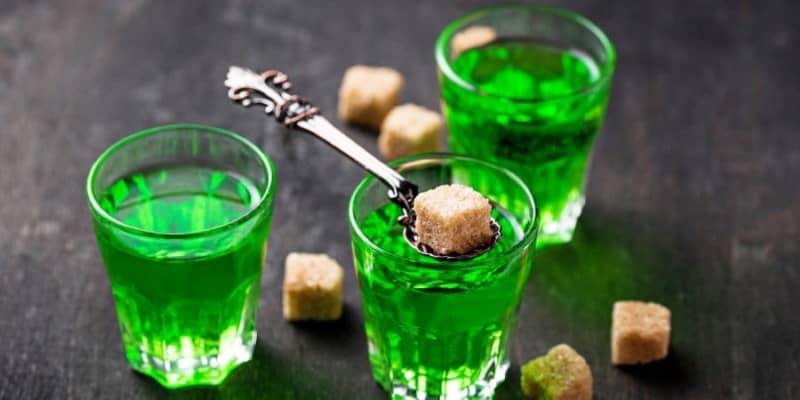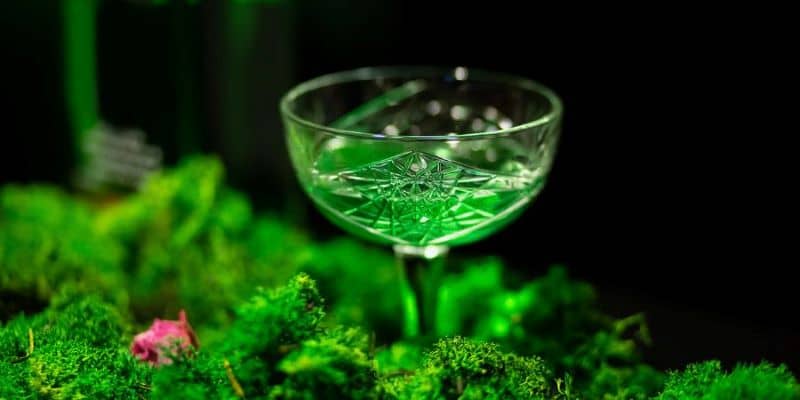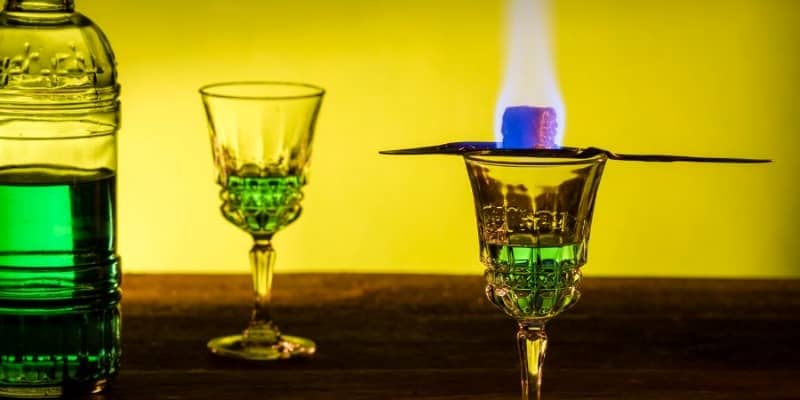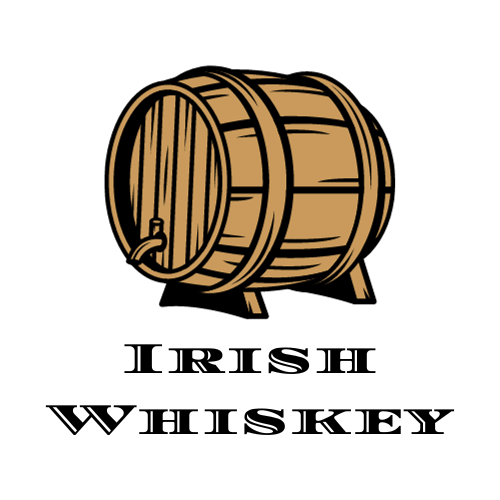Have you ever wondered what absinthe, the famously banned “green fairy” liquor, actually tastes like? This anise-flavored spirit has developed quite the mystique over the years, but its flavor remains something of an enigma to many. Absinthe is a strong alcoholic spirit that has been around since the 18th century.
Let’s explore the complex and evolving world of absinthe tastes.
The Flavor Profile
Absinthe begins with a base spirit, often a neutral grain spirit or grape-based eau de vie. Botanicals like anise, fennel, and wormwood are then macerated and distilled with the base. When drinking absinthe, you’ll immediately notice the presence of anise. This is the essential flavor that defines the experience.
Green Anise – The Sweet
Anise imparts absinthe with a sweet, liquorice-forward taste. It creates a slight numbing sensation on the tongue and leaves a cooling aftertaste. The anise flavors will be prominent from the first sip. You may also pick up traces of star anise and fennel, which share a similar aniseed quality.
Wormwood-The Bitter
As a key botanical in absinthe, wormwood offers bitterness to balance the sweet anise. Wormwood provides earthy, herbal notes as well as subtle citrus highlights. It’s the ingredient responsible for absinthe’s emerald green hue. When consumed, wormwood showcases a dry, warming bitter finish.
Fennel – The Spicy
Finally, fennel joins the party, adding powdery, perfumed elegance. You’ll detect fennel’s faint whispers of citrus and subtle spiciness.
Secondary Botanicals
Depending on the recipe, absinthe may contain supplemental herbs like hyssop, lemon balm, angelica root, coriander, and nutmeg. These botanicals introduce supplementary flavors such as menthol, citrus, and spice. However, they play a supporting role to the starring anise and wormwood.
The Louche Effect
When water is gradually added to absinthe, a magical transformation called the louche occurs. The essential oils from the herbs emerge from the alcohol solution, creating an opaque, cloudy drink. These precipitating oils carry a wealth of floral, herbal aromatics to the nose.
As water integrates into the absinthe, you’ll observe a fascinating dance of flavors. The anise steps forward right away before slowly dissolving into the background. Meanwhile, traces of honey and fruit emerge where none existed before. The wormwood’s bitterness declines while its subtle citrus qualities strengthen. It’s an elegant ballet of tastes that must be experienced firsthand.
Also Check: What Is A Liqueur? Definition And Characteristics
Factors That Shape Absinthe’s Flavor Profile
From distillery to distillery, no two absinthes taste exactly alike due to choices made during production. Here’s what influences the Green Fairy’s flavors:
Ingredients & Botanical Blends
An absinthe’s ingredient list including wormwood type, additional herbs used, and their quantities steer its overall flavor direction. One brand’s recipe might skew herbal and dry, while another veers sweet and heavy on anise.
Alcohol Content
Most absinthe contains 60-72% alcohol before dilution, with some reaching up to 85% ABV. High proof intensifies botanical flavors, making them bolder and more assertive.
Distillation Method
Whether absinthe is distilled in pots stills or column stills affects how the flavors come through. Pot stills better preserve fragile herbal essences that column stills can strip out.
Cold Mixing vs. Distillation
Some lower-quality absinthes skip distillation altogether, merely mixing herbs and alcohol. This produces duller flavors compared to the dynamic tastes extracted via proper distillation.
Sweetening
While traditional absinthe uses no added sugars or artificial sweeteners, some modern commercial brands include additives post-distillation for sweetness and smoother drinking. Too much sweetness though can flatten out the botanicals.
Aging
Aging mellows out rough edges, integrates the flavors, and contributes subtle oak undertones. Unaged “white” absinthes deliver brighter, greener, more aggressive taste compared to aged expressions.
Blending
For consistency across batches, absinthe producers create pre-bottling blends mixing old and new distillates along with neutral alcohol as needed. Blending impacts flavor balance and intensity.
Louche Effect
Adding cold water triggers absinthe’s cloudy louche effect as the anethole from anise precipitates out. Beyond looking gorgeous, the louche unlocks subtler botanical flavors obscured by the dominant anise as it dilutes.
“Well tickle me thrilled, there are even more flavors blooming with a splash of water!” you might gleefully proclaim mid-louche. “This gets more fascinating the deeper I dive in!”

Preparing Absinthe for Optimal Flavor Delivery
Serving absinthe properly liberates its fullest flavor. Follow this preparation process for ideal enjoyment:
Step 1 – Pour 1-2 oz absinthe into a glass
Start by gauging your preferred serving size of absinthe. One ounce makes a light serving for sipping, while two ounces provides a bolder pour.
Step 2 – Place a sugar cube on an absinthe spoon over the glass
Adding a sugar cube bumps up absinthe’s sweetness if desired, countering wormwood’s bitterness. The classic crescent-shaped absinthe spoon suspends the sugar over the glass.
Step 3 – Slowly pour chilled water over the sugar until the louche effect activates
Next comes the fun part! Add 3-5 parts ice cold water for every 1 part absinthe. Pour slowly and watch the magical louche transform opaque green. The perfect ratio hits the absinthe’s ideal proof for full flavor potential.
Step 4 – Briefly stir then enjoy!
After adding water fully, give a quick stir to dissolve the sugar cube, then appreciate the multifaceted flavors of properly prepared absinthe. Santé!

Deciphering Flavor Profiles From various Absinthe Brands
Absinthe’s taste differs greatly across various distilleries and countries. Let’s analyze regional flavor profiles:
French Absinthe
Known for elegance and complexity, Premium French absinthe leans botanical-forward with pronounced anise, fennel and wormwood, followed by supporting herbs. Common traits include:
- Prominent anise – Strong sweet licorice notes
- Reserved sweetness – Light sugar usage; drier taste
- High complexity – Lots of minor botanicals detectable
- Ruinous wormwood bitterness (in bad products) – Aggressively bitter, unbalanced
“Mon dieu, such fine French flavors!” you might trill after tasting a top-quality French absinthe. “The botanicals dance across my palate with grace and charm!”
Swiss Absinthe
Smooth and easy-drinking, Swiss absinthe tends to emphasize sweeter anise flavors over wormwood’s bite. Common traits include:
- Emphasized anise – Very sweet, almost candy-like
- More robust sweetness – Higher sugar content balances bitterness
- Simple botanical base – Focused on core herbs rather than complexity
- Mild wormwood presence – Light, inoffensive bitterness
“By yodeling yessiree, them Swiss sure know how to craft a mighty fine, mellow absinthe!” your taste buds might croon after a Swiss absinthe. “No aggressive wormwood here, just delicious botanical sweetness with a kiss of bitterness!”
Spanish Absinthe
Newer to legal absinthe production again, Spanish expressions chase uniqueness. Watch for oddball botanicals like basil, mint, or nutmeg. Common traits include:
- Surprising herbs and spices – Experimental secondary botanicals
- Full body – Robust mouthfeel with rich texture
- Fruity leanings – Hints of berry, citrus, stone fruit from herbs
- Generous sweetness – Added sugars smooth out bitterness
“Ay caramba, these unusual Spanish absinthes spice things up!” you may exclaim. “Who’d have thought I’d taste pineapple and paprika in my glass? ¡Salud!”
Bohemian Absinthe
Absinthe originating from the Czech Republic and surrounding areas offers rustic, folksy flavors. Common traits include:
- Kitchen garden herbs – Savory herbs like dill, celery, & lovage
- Full-throttle wormwood – Very high bitterness
- Earthy qualities – Hints of forest floor and undergrowth
- Faint anise – More bitterness than sweetness
“Well butter my biscuit, this Bohemian booze is bitter as a Billy goat’s backside!” your taste buds might yelp. “The woody wormwood and garden herbs make for a mighty mean absinthe in need of extra sugar to tame its wild side!”
As you can see, absinthe hailing from different regions provide unique tasting experiences spanning sweet to bitter, simple to complex. It takes drinking various kinds to fully answer that lingering question: “What does absinthe taste like?”

Does Absinthe Make You Hallucinate?
No, absinthe taste does not actually make you hallucinate. While absinthe has a myth and lore of causing psychedelic effects, modern scientific analysis shows the thujone content is much too low. The high alcohol can lead to odd behaviors when drinking to excess, but good quality absinthe itself does not make people hallucinate. The stories of spectacular visions are exaggerated rumors from decades ago. When prepared properly, absinthe unveils its complex herbal flavors without any secondary mind-altering effects.
What Strength is Absinthe Compared to Other Spirits?
Given its legendary reputation, you may be surprised to learn absinthe typically ranges between 45 to 74% ABV! In comparison to other liquors, here’s how it stacks up:
- Vodka: 40-50% ABV typically
- Gin: 43-57% ABV depending on style
- Whiskey: 40-60%+ ABV (higher for cask strength)
- Rum: 40-50% ABV normally
- Tequila: 38-50% ABV depending on class
So while absinthe can be potent, rums and whiskeys often reach comparable strengths. Of course, absinthe’s complex herbal infusion sets it clearly apart from other spirits in terms of flavor!
Frequently Asked Questions
What gives absinthe its flavor?
Absinthe’s flavor comes primarily from its botanical ingredients, especially wormwood, green anise, and fennel. The quantities used and distillation methods also affect the taste profile.
Does absinthe taste like Jägermeister?
No, absinthe and Jägermeister have very different tastes. Absinthe tends to taste drier, more bitter, and strongly of anise, while Jägermeister tastes much sweeter due to added sugar and its blend of over 50 herbs and spices.
Is wormwood dangerous to drink?
In moderation, no. Modern regulated absinthe only contains safe, non-toxic thujone levels from wormwood. Drinking excessive volumes can cause side effects though.
What does real absinthe taste like?
Authentic, properly-made absinthe offers layered herbal flavors with sweet anise, bitter wormwood, spicy fennel, and supplemental herbs. Bad absinthe tastes sharply bitter, unnatural, or dull.
How does absinthe make you feel after drinking it?
How one feels after drinking absinthe would depend on many factors, including the amount consumed and a person’s tolerance. However, it’s best for health and wellbeing to avoid overconsumption of alcohol, including absinthe.
Final Thoughts
As you keep trying different absinthes, take note of the flavors you enjoy most. Seek out brands that align with your personal taste preferences. Whether you like the sweetness of anise or enjoy more bitter, herbal notes, there’s an amazing variety of botanical flavors to uncover in the world of absinthe.
Pay attention to what your tastebuds tell you with each fresh sip. Part of the delight is finding that perfect absinthe that makes you smile each time its unique combination of tastes hits your tongue.


